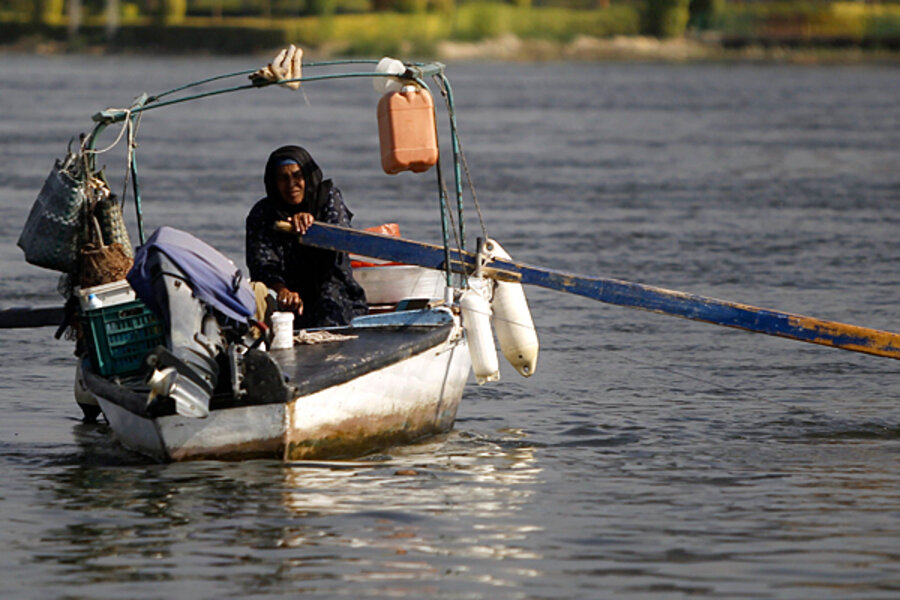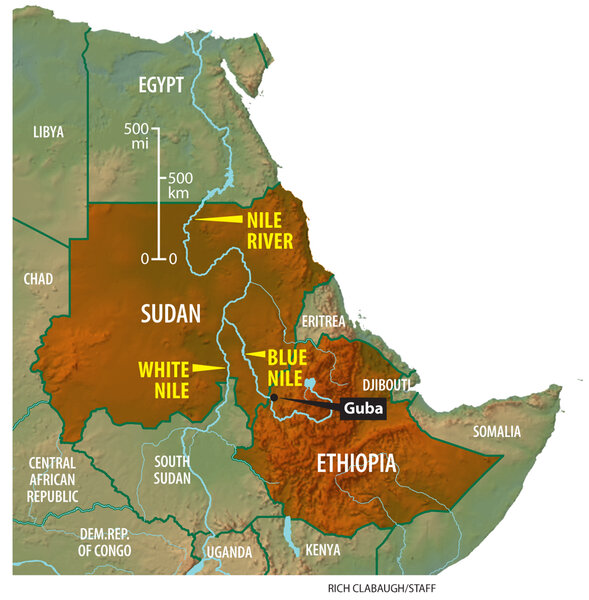Will Ethiopia's 'grand' new dam steal Nile waters from Egypt?
Loading...
| Guba, Ethiopia
Egypt is newly worried about a huge Ethiopian dam now under construction on the Nile’s main tributary – a concern that reflects arid Egypt’s overwhelming reliance on the world's longest river.
Egypt and the Nile are bound together: The Nile, called "God's gift to Egypt," helped the nation become one of the first agricultural civilizations, and it still supports most farming there.
But Ethiopia – the source of almost 86 percent of the water flowing to Egypt – is equally adamant that it has been denied a fair share of the river by agreements between Sudan and Egypt in the 1950s that divided the river between them.
Ethiopia two years ago started building what will be Africa's largest dam on the Blue Nile. It is a clear indication, despite anger from Egypt, that upstream Nile countries will no longer simply accept what they feel are inequitable water-sharing deals.
Ethiopia says its Grand Ethiopian Renaissance Dam, 20 miles from the Sudanese border, will not be used for irrigation. That means that once the 6,000-megawatt hydropower station is at full generating capacity, it will not consume precious water flowing to Egypt.
Yet Ethiopia’s decision on how quickly or slowly to fill a needed reservoir with Nile water flowing toward Egypt, plus potential rates of evaporation, are major potential sources of contention between the two nations.
After heated rhetoric, including military threats by Egypt and an unbending response by Ethiopia, the nations' two foreign ministers met last week. They agreed to study the dam’s potential impact – but only as construction proceeds.
Ethiopia aims to fill the needed new dam reservoir quickly, in five years, to start generating power. Experts say five years is ambitious. They argue that wildly varying levels of rainfall in the Blue Nile basin requires a flexible approach. The job may take 20 years, in this view.
To divert water into the new reservoir quickly, especially in low-rain years, may bring harm downstream, they say.
Long-term strategy
Yet in the long run, the Nile water can be conserved by moving storage away from inefficient dams such as the Aswan High Dam, which straddles the scorching border of Egypt and Sudan, and into cooler Ethiopia where there is lower evaporation.
As for evaporation rates, no consensus or exact science exists. But more usage and storage in Sudan and Ethiopia – and a reduced volume at Aswan – could save some 4 billion cubic meters of water a year, some studies say.
When it is filled, Ethiopia’s new reservoir or artificial lake will be about half the size of the US state of Rhode Island. Filling may start towards the end of next year, and swallow hills, forests, roads, bridges, and villages in this far-flung corner of western Ethiopia.
Last month, Italian dam builder Salini Costrutorri hosted a ceremony to mark the diversion of the Blue Nile as part of the construction process.
Flash point: the filling of the reservoir
While that step raised ire in Egypt, it is more the reservoir filling that is a "major concern" to Sudan and Egypt, said an Ethiopian government official, Debretsion Gebremichael, who wore a red cap marked Salini in the sweltering opening ceremony.
The volume of water to be captured in the reservoir is 74 billion cubic meters (bcm), according to project documents. That figure is almost equivalent to the entire annual volume of the Nile that flows into Egypt's High Aswan Dam, or 84 bcm.
If Ethiopia decided unilaterally to fill the reservoir as quickly as possible, that would be disastrous for Sudan and Egypt. It would consume the entire flow of the Blue Nile, or around 54 bcm, for more than a year.
The Ethiopian ministry of water and energy says it wants to fill the reservoir over a period of five or six years. Mr. Debretsion says Ethiopia is willing to “accommodate” other nations.
To fill the dam over a six-year period would mean 14 to 18 percent less Nile water moving to Egypt each of those years, if rainfall is average and the dam is filled evenly. That is the idea in Addis Ababa, the Ethiopian capital.
Experts say that idea may not be so simple. It is unlikely that water can be impounded evenly in an area where rainfall and river volumes vary dramatically, says Simon Langan, director of Nile Basin and East African studies at the International Water Management Institute (IWMI).
Ethiopia's Blue Nile, for example, has run as high as 70 bcm in 1929, and as low as 30 bcm in 1972 and 1984, this from a 2008 study of sediment in the Nile by Abdalla Abdelsalam Ahmed, a UN water expert from Sudan.
"They will draw ‘excess’ water during the wet season," Mr. Langan says. "With some proactive management, hopefully it could be varied even more with greater amounts of water in wet years and smaller amounts in drier summers."
Most of the Blue Nile's flow follows a three-month rainy season in the Ethiopian highlands that ends around September.
Filling the dam only during rainy season in wet years would mean "the effects on downstream users may be quite small," says Aanund Killingtveit, professor of hydrolics and environmental engineering at the Norwegian University of Science and Technology.
But that approach could take decades, argues Paul Block, an expert on from Drexel University in Philadelphia, who has been modeling the impact of the reservoir filling in light of climatic variability.
The approach to capturing water needs to be "flexible" depending on how much rain falls in Ethiopia's Blue Nile basin, Langan says. If the first few years of filling were "drier years this could have drastic implications," agrees Mr. Block, who is a professor of civil engineering and an expert on climate risk modeling and hydrologic forecasting.
Unpredictable future rainfull patterns complicate a scenario where Ethiopia wants to fill the dam as quickly as possible to generate electricity for export.
If Ethiopia fills the dam with 25 percent flow of the Blue Nile per year, the dam will fill in 11 years, says Block; if Ethiopia diverts only 10 percent, the time will extend past two decades, he figures.
Michael Hammond, a hydrologist from Exeter University in the UK, says such figures are about right. Yet even with less water in Aswan's reservoir, which holds a huge 150 bcm, Egypt may not lose out.
"My understanding is that if the impoundment is managed and operated well, Egypt could be assured a highly reliable supply of 55 bcm per year," Mr. Hammond argues. This is the figure Egypt set in a historic 1959 deal with Sudan.
Evaporation rates can be managed by small-scale conservation and reduce the some-500 bcm current loss in Ethiopia's highlands, says Langan. When the Renaissance dam is at full volume, it may have a loss only a fifth of the Aswan Dam’s evaporation, or 10 bcm a year, according to the numbers offered by Block, whose studies are about to be peer-reviewed.








